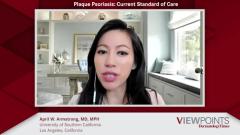
Biologic Therapies for Plaque Psoriasis: Treatment Limitations
During a brief discussion on current treatment challenges in plaque psoriasis, key opinion leaders in dermatology highlight patient access and affordability of newer biologic therapies as the biggest hurdles faced by clinicians.
Episodes in this series

Andrew F. Alexis, MD, MPH: In the remaining few minutes of our discussion, I’d like to focus on treatment challenges and unmet needs. Let me open this part of the conversation with a question. What are some of the key challenges you face when managing plaque psoriasis? I’ll start with Dr Boh.
Erin E. Boh, MD, PhD, FAAD: One is access, or certainly affordability. What I find is that insurance companies, especially if you look at them, tend to deny a lot of coverage. Access and having it affordable for patients is also important. One of my biggest unmet needs—I guess it’s not my need but psoriasis patients’ needs—is I have a huge group of people who are now turning 65 years old. The Medicare population just gets terribly put to the side. You could be on a biologic from your commercial insurer for 15 years and doing great, then you turn 65 and you can’t get anything.
It’s very frustrating. The frustration is made even worse because these Medicare plans will approve the psoriasis drugs, but it’s tier 5. That means your co-pay is $2000, $5000 a month, and you’re on Medicare. Then you have these patients who had been enjoying the benefit of the IL-17s, IL-23s, or whatever they’re on, improving their health, and they can no longer get the drug. The only drugs we can get are infliximab or the tildrakizumab if you go through the Medicare major medical. The Medicare population is a big group of people we need to access the medicine for.
When they get approved, the companies can’t give them the medicine because they’re approved; they just can’t make the co-pay. That’s 1 big group. I used to say another group of unmet needs was pediatrics, but that’s really blossoming now, and we’re seeing a number of drugs entering into the pediatric population for psoriasis. There are the TNFs [tumor necrosis factor inhibitors], there’s ustekinumab. There are a number of different classes that are going down to at least age 12. Of course, with the TNFs, it’s down to age 4. That population is going to even see more benefit from these biologics in the future as we see the better safety profiles with them as opposed to traditional agents.
Summing it up, the biggest things are the cost of the drugs and access once you hit a certain age. One of my frustrations is that patients go, “I’m clear on my medicine, so I’m just going to stop it because I’m cured.” You’re going, “No, you’re not.” Then they come back 5 or 6 months later covered with their psoriasis, and you’ve got to start the whole process over. That’s a good problem to have because most patients do respond.
Andrew F. Alexis, MD, MPH: Thank you, Erin. You touched on the challenges of cost and access, as well as longer-term adherence. Let me open it up to everyone. If you could briefly comment on what you think our role is as dermatologists and other health care providers who prescribe biologics. What’s our role in facilitating access for our patients given that we have these barriers that we just talked about? What do you do in your office to facilitate this process?
Erin E. Boh, MD, PhD, FAAD: You fight, fight, fight with the insurance company.
April W. Armstrong, MD, MPH: I absolutely agree. Yes, I—
Erin E. Boh, MD, PhD, FAAD: You fight the insurance company.
April W. Armstrong, MD, MPH: I think—and you just have to be persistent.
Erin E. Boh, MD, PhD, FAAD: Yes.
April W. Armstrong, MD, MPH: Oftentimes they will keep denying, and you just really have to have a bone in the game. Tell your patients that you are persistent on that. Andrew, if I may, I had 3 quick points on what I thought is the unmet need. One is, I see a lot of my patients who respond really well in the beginning, but then over time, they start to lose response. If we can advance as a field—in terms of research, understanding the predictability of who would do what in the future—it would be great.
Also, the long-term implications of treating our pediatric patients. I’m not necessarily saying the safety concerns, but just understanding. Are we doing any disease modification in this patient population by treating them earlier? There’s a lot to learn about that. One of the biggest battles that I find myself fighting—maybe it’s because I’m in Southern California—is just the social media information to our patients regarding therapies who really don’t work, that they are really latching onto them. In the process, they’re really losing time that they could be having in terms of going to proved therapies that have been FDA approved. That’s 1 unmet need as dermatologists that we want to take an active role in, in terms of educating our patients with regard to evidence-based medicine.
Andrew Blauvelt, MD, MBA: I want to highlight some of the things that April just said. If we look purely at the numbers of people with psoriasis and then cut that to the people who have moderate to severe psoriasis and then cut that to the people who are on biologic therapy, it’s a woefully low percentage of patients who need biologics are on them in this country. A lot of that has been because of misinformation on the internet, as April mentioned, and reticence by dermatologists who don’t want to take the effort and the time to fill out prior authorizations or to learn about a new biologic.
That’s an area for our specialty that has been a sore spot. I always say to folks wanting to do it or looking at doing it, just put the patient first, just think about that human being in front of you. If it was your brother or your mother, would you want them to go on methotrexate? Would you want them to go in the light box in 2020 knowing all the wonderful things we have that are so much better than those 20th-century therapies, which unfortunately are still being used by so many dermatologists because that’s how they were trained and they don’t want to deal with prior authorization. It’s not patient centered.
I’m not admonishing. I’m just trying to get people to think about putting yourself in the shoes of that person in front of you. What would you want? You would want the best therapies. We’ve got terrific ones now. I really think more dermatologists should be prescribing biologics.
Erin E. Boh, MD, PhD, FAAD: Andy, if I could mention 1 unmet need. If we could get this, it would be so helpful for all patients: going down that road of personalized medicine. If we could find the individual’s genetic defect. Andy mentioned very early in the talk that we have 2000 gene mosaicisms in psoriasis. But not every psoriasis patient has the same defect. If we could find that genetic expression that’s driving that person’s psoriasis, then you pick the drug, and it would be so cost effective.
You wouldn’t have to go through this step therapy. You wouldn’t have to have people getting unnecessary treatments or not responding and getting those frustrations. You find what the defect or the mutation is in that patient and then target that defect. Then you’ll get a home run every time.
Andrew F. Alexis, MD, MPH: Yeah, that really is the holy grail, isn’t it?
Erin E. Boh, MD, PhD, FAAD: It is.
Newsletter
Like what you’re reading? Subscribe to Dermatology Times for weekly updates on therapies, innovations, and real-world practice tips.























